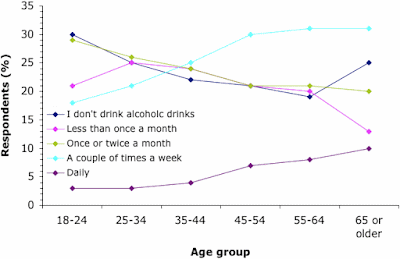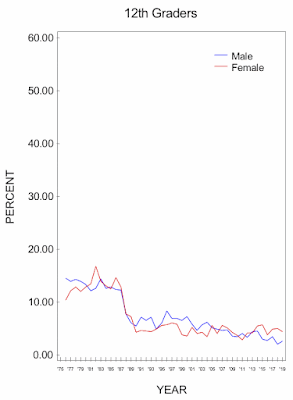Moreover, most of the data presented tends to compare 2020/21 with only 2019; but what about long-term trends? The data I have used to look at this question comes from Wine Sales in the USA (includes wine shipments from within the U.S. states and foreign producers entering U.S. distribution). It covers the volume of sales over the years 2009 to 2020, inclusive, by category. The first graph shows the total (in black), plus each of the four categories separately.
It is clear that total sales increased steadily over time. For example, sales were 25.6% higher in 2019 compared to 2009, which represents a cumulative increase of 2.3% per year. This greatly exceeded the increase in population over the same period of time, which went up only 7.4% (according to Worldometer). So, the wine industry in the USA was apparently very successful during the second decade of the 21st Century, in the commercial sense, and industry-wide.
It is also apparent in the graph that there was a distinct up-tick in wine sales during 2020, marking the start of the Covid-19 pandemic. Wine sales increased by 7.0% in that year alone, which was 3 times the annual increase over the preceding decade. Some, at least, of the wine industry accountants are presumably even happier about this.
This does not, of course, mean that each individual U.S. winery is financially happy. For example, it has been reported that Wine sales are up but winery profits down, due to increasing market share by the bigger wineries, along with a pronounced shift to cheaper wines. That is, not all wineries have been in a position to benefit from the increased sales, especially given the noted switch from shop sales to online sales.
If we now look at the four wine categories individually, we can see that the steady increase in total sales was principally due to table wine, as also was the 2020 up-tick. However, the other three categories were somewhat different, as shown in the second graph, which pulls them out separately.
We can see that sparkling wine also followed a nice steady increase over the decade, but had a distinct down-turn in 2020, instead of going up. Perhaps not too many people were celebrating in that year: Champagne loses its fizz as pandemic hits sales. Mind you, this could also be part of the shift to less expensive wine: From the pandemic to Prosecco: Why Champagne sales are plummeting; along with the recent export difficulties due to a trade dispute with the USA.
Dessert wine has had a somewhat rocky ride in the graph. The increase in dessert wine sales started in 2013 and ended in 2016; and it has been pretty steady since then, including in 2020. The change in sales may represent a transition from Millennials to Generation Z amongst consumers. That is, it starts with the arrival of late-period Millennials at drinking age, and ends with the arrival of early Generation Z drinkers.
The flavored wine products maintained fairly steady sales for most of the decade. However, a distinct up-turn started in 2019, which then became a boom in 2020. This coincides with the arrival of increasing numbers of Generation Z consumers at drinking age (i.e. those born in 2000/01). Generation Z is formally defined as including those people born from 1997—2012; and they will thus be an increasing component of wine consumers until at least 2030.
This latter point will be interesting if the down-tick in sparkling wine sales is in any way related to the boom in flavored wine products. A recent survey has concluded that: American Gen Z are thoughtful boozers. This apparently means that they do not behave anything like their predecessors, the Millennials (born 1981—1996). For example:
According to the survey, 68% of Millennials — those between 25 and 40 — said the celebrity endorsement influenced their buying decisions, while 86% of the Gen Z buyers said they could care less.That is quite a difference! In terms of preference for flavored wine products, the report also notes:
RTDs are beginning to drink hard seltzer’s lunch. “While the breakout drink of 2019 and 2020 is still growing, it’s not what 21-plussers say they will reach for first this summer,” Drizly says. “Ready-to-drink cocktails and other new canned drinks are playing off of hard seltzer’s innovation, and, in the process, taking some of its growth momentum.”Perhaps the biggest issue is that there is reported to be a decreasing level of recruitment among Generation Z wine drinkers in the USA, which may slow any continuation of the patterns shown in the graphs above. Wine marketers have now been warned!





















